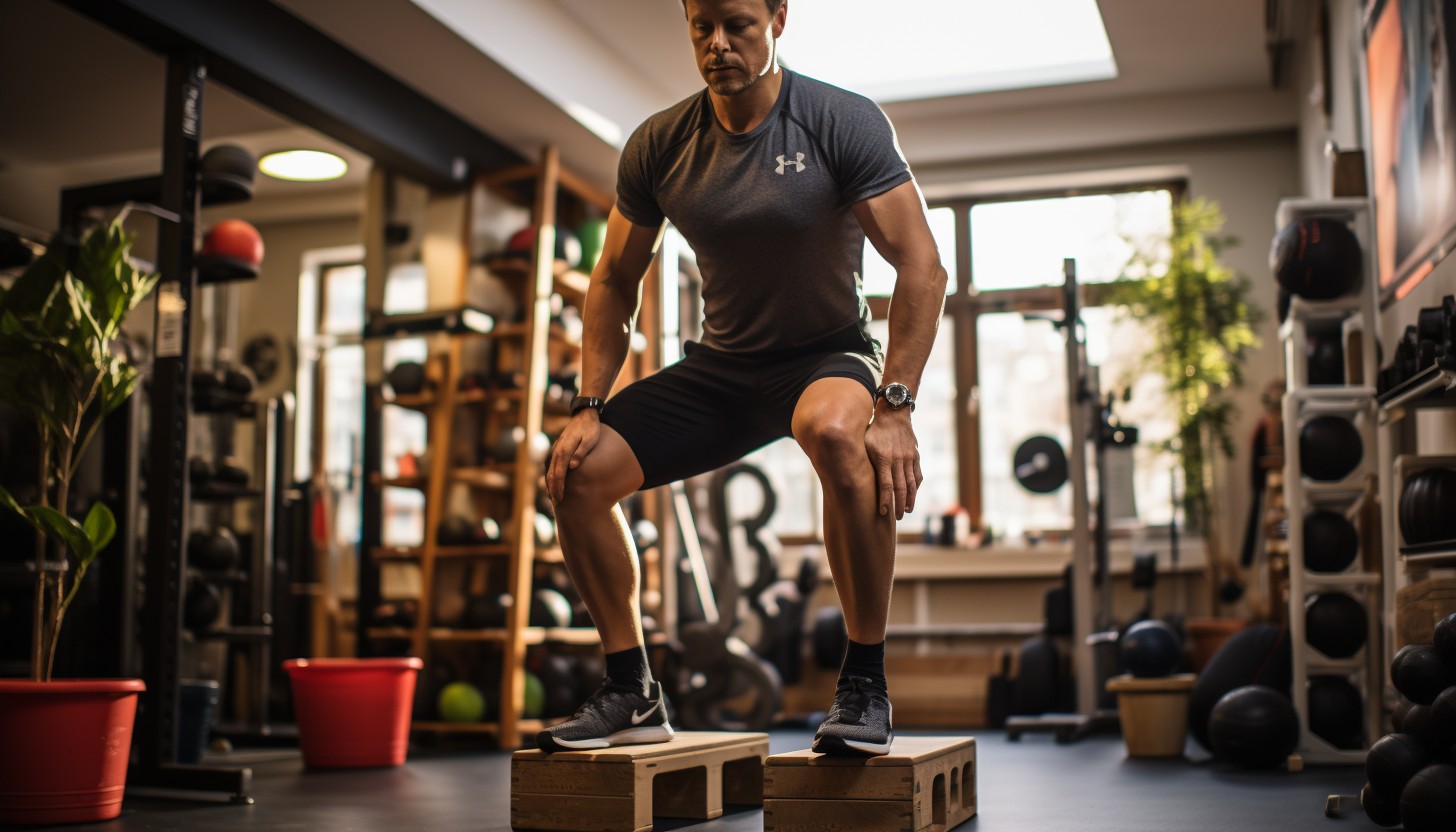Strengthening Exercises for Recovering From Runner’s Knee

Imagine you’re a runner, eager to hit the pavement again after recovering from runner’s knee. But wait! Before you lace up those shoes, it’s crucial to strengthen your muscles for a smooth and pain-free comeback.
In this article, we’ll guide you through a series of recommended strengthening exercises tailored specifically for runner’s knee recovery. By targeting key muscles and gradually progressing, you’ll be able to incorporate these exercises into your recovery plan and get back on track stronger than ever before.
Importance of Strengthening Exercises

You need to understand the importance of doing strengthening exercises for your recovery from runner’s knee. Strengthening exercises not only help with the rehabilitation process but also have numerous benefits for your overall fitness.
Engaging in regular strength training can improve muscle tone, increase bone density, and boost metabolism. It can also enhance athletic performance and prevent future knee injuries.
When you strengthen the muscles around your knees, such as the quadriceps, hamstrings, and glutes, you provide support to your knee joint and reduce stress on it during physical activities like running or jumping. By targeting these key muscles, you improve their endurance and stability, which in turn protects your knees from further damage or strain.
Additionally, strong muscles help maintain proper alignment of the joints, preventing imbalances that could lead to overuse injuries like runner’s knee. When certain muscles are weak or inactive, other muscles compensate for them, causing biomechanical issues that put excessive pressure on the knees.
Key Muscles to Target

To effectively target the key muscles for runner’s knee recovery, it’s important to focus on engaging the quadriceps and glutes through exercises like squats and lunges. These exercises help strengthen the surrounding muscles and provide support to the knees during activities like running.
Runner’s knee, or patellofemoral pain syndrome, is a common overuse injury that affects many athletes. It is often caused by repetitive stress on the knee joint, such as excessive running or jumping. Weakness in the quadriceps and gluteal muscles can contribute to this condition.
By incorporating targeted exercises into your rehabilitation routine, you can not only recover from runner’s knee but also prevent future occurrences of this painful condition. The table below outlines some effective exercises that will engage these key muscle groups:
| Exercise | Description | Sets | Reps |
|---|---|---|---|
| Squats | Stand with feet shoulder-width apart | 3 | 10-15 |
| Lunges | Step forward with one foot | 3 | 10-12 |
| Leg Press | Sit on a machine with feet on a platform | 3 | 12-15 |
| Glute Bridge | Lie on your back with knees bent | 3 | 10-12 |
Incorporating these exercises into your workout routine can help strengthen the quadriceps and glutes, providing stability and support to your knees. Remember to start slow and gradually increase intensity as your strength improves. Additionally, proper form is crucial to avoid further injury.
Recommended Strengthening Exercises

Incorporating these targeted exercises into your routine can help strengthen the key muscles and provide stability to your knees. Here are some effective techniques for preventing future injuries:
– Quad Strengthening: Perform exercises like leg extensions, squats, and lunges to strengthen the quadriceps muscles, which play a crucial role in knee stability.
– Hamstring Strengthening: Engage in exercises such as hamstring curls and deadlifts to target the hamstrings, which help balance out the strength of the quads and support knee function.
– Hip Strengthening: Include exercises like hip bridges, lateral leg raises, and clamshells to strengthen the hip muscles. Strong hips can improve alignment and reduce stress on the knees.
By regularly incorporating these strengthening exercises into your routine, you can effectively improve muscle imbalances and enhance overall knee stability. This will not only aid in recovering from runner’s knee but also prevent future injuries.
Remember that consistency is key when it comes to reaping the benefits of these exercises. Start with lighter weights or variations that suit your current fitness level and gradually increase intensity as you progress.
Don’t forget to listen to your body and consult with a healthcare professional if you experience any pain or discomfort during these workouts.
Progression and Modifications

When progressing through these targeted techniques, it’s important to gradually increase intensity and make modifications based on your current fitness level. This will help you avoid overexertion and ensure a safe and effective recovery from runner’s knee. Here are some key points to keep in mind when it comes to progression and modifications:
1. Gradually Increase Intensity: Start with low-intensity exercises and slowly increase the difficulty as your strength improves. This allows your body to adapt and reduces the risk of aggravating your injury.
2. Listen to Your Body: Pay attention to any pain or discomfort during exercises. If something doesn’t feel right, modify the exercise or take a break. Pushing through pain can lead to further injury.
3. Modify Exercises: If an exercise feels too challenging or causes pain, there are usually alternative options that target the same muscle group without straining your knee. Consult with a physical therapist for guidance on appropriate modifications.
4. Cross-Training: Incorporating other forms of exercise like swimming or cycling can provide additional cardiovascular benefits while giving your knees a break from high-impact activities.
Remember, proper progression and modifications are essential for recovering from runner’s knee safely and effectively. By listening to your body and making necessary adjustments, you can continue strengthening without risking further injury.
| Progression Modifications | Avoiding Overexertion |
| Gradually increase intensity | Listen to your body |
| Modify exercises if needed | Take breaks when necessary |
| Incorporate cross-training | Monitor for signs of overexertion |
| Seek professional guidance | Pace yourself |
Incorporating Strengthening Exercises Into Your Recovery Plan

By gradually increasing the intensity of your workouts, you can effectively incorporate targeted techniques into your recovery plan.
As you recover from runner’s knee, it is crucial to focus on strengthening exercises that promote muscle balance and stability. Cross training during this time can offer several benefits, including:
– Reduced impact: Engaging in low-impact activities such as swimming or cycling allows you to maintain cardiovascular fitness without aggravating your knee.
– Muscle variation: By engaging different muscle groups through activities like yoga or Pilates, you can prevent overuse injuries while still working towards a full recovery.
– Enhanced mobility: Incorporating exercises that improve flexibility and joint range of motion helps alleviate stiffness and tightness, promoting overall joint health.
In addition to cross training, stretching exercises should be an integral part of your recovery plan. Here are some tips for incorporating stretching into your routine:
1. Dynamic stretches before exercise: Perform movements like leg swings or walking lunges to warm up the muscles and increase blood flow.
2. Static stretches after exercise: Hold gentle stretches for 30 seconds per muscle group to enhance flexibility and reduce post-workout soreness.
3. Regular foam rolling: Use a foam roller to loosen tight muscles and release tension in areas surrounding the knee.
Conclusion
Congratulations on completing the article! Now, it’s time to put all that valuable information into action.
By incorporating these strengthening exercises into your recovery plan, you’ll be well on your way to overcoming runner’s knee and getting back to doing what you love.
Remember, consistency is key, so stick with it and gradually increase the intensity of your workouts as you progress.
With dedication and perseverance, you’ll soon be stronger than ever before.
Stay tuned for more tips and tricks to enhance your fitness journey!






